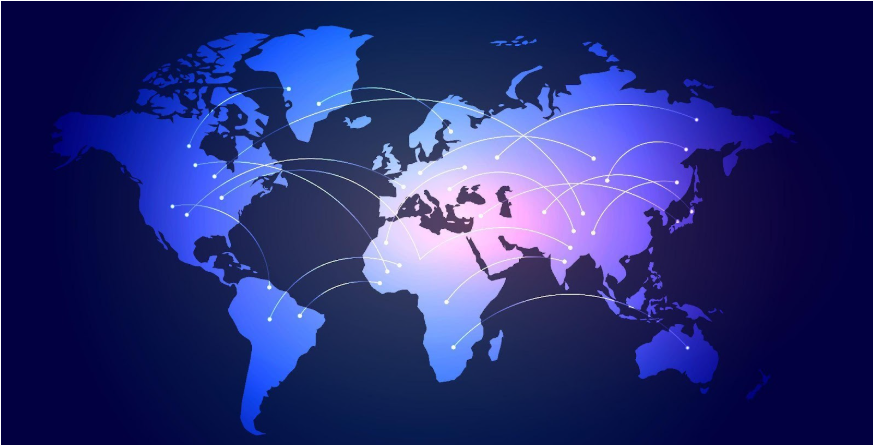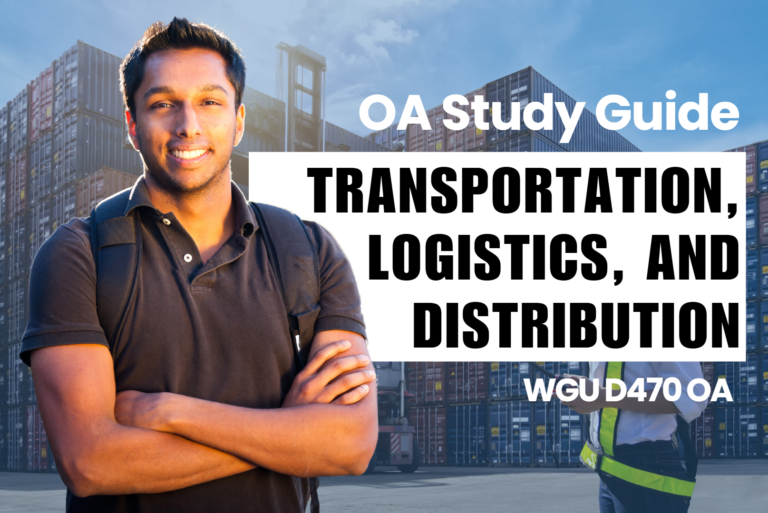WGU C211 OA Study Guide - 2025 | A Simple Guide to Market Structures, Globalization, and Trade Theories📖
Ready to explore the world of global economics? Ever wondered how countries decide who gets what or how businesses price their products? In this article, we’ll break down three key ideas that shape the global economy: globalization, international trade theories, and market structures.
This article explores three key economic concepts that shape global trade, market dynamics, and business strategies:
- Different Views on Globalization: New, Evolutionary, and Pendulum: Globalization is viewed differently by economists and policymakers. The New perspective sees it as a recent phenomenon, the Evolutionary view considers it a long-term historical process, and the Pendulum theory suggests globalization moves in cycles, influenced by economic and political shifts.
- Classical vs. Modern Theories of International Trade: Trade theories explain how and why countries engage in global commerce. Classical theories like Mercantilism, Absolute Advantage, and Comparative Advantage focus on national wealth and efficiency, while modern theories incorporate factors like economies of scale, technology, and global supply chains.
- Types of Market Structures: Markets function under different structures based on competition levels. Competitive markets have many sellers and free pricing, monopolies involve a single dominant seller, and oligopolies feature a few powerful firms controlling an industry.
For WGU C211 students, understanding these structures is crucial for acing your WGU C211 OA questions. So, let’s dive in—no jargon, just the basics you need to get ahead and understand how the global economy works!
How to Use This Guide for the WGU C211 OA Exam?📖
The C211 Global Economics for Managers OA exam at WGU evaluates your understanding of global economic principles, international trade theories, and market structures. This guide simplifies the key concepts of different views on globalization, classical vs. modern theories of international trade, and types of market structures to help you grasp the topics tested in the exam.
We also provide exam-style questions and practical applications to ensure you’re fully prepared for the questions on the WGU C211 OA exam.

Different Views on Globalization For C211 OA: New, Evolutionary, and Pendulum📝
The term globalization serves as a common expression in economic discourse political circles, and business contexts. But what does it really mean? Globalization describes the global connections that nations establish through the exchange of trade together with technological development and cultural interactions. The connections of globalization affect both food selection at dinner time and worldwide job possibilities. Students taking WGU C211 need to fully grasp globalization concepts since the knowledge enables them to understand global trade and economics fundamentals.
Multiple experts disagree about both the workings of globalization and its primary motivational elements. Scholars disagree about the origins of globalization attributing its nature to both modern times as well as ancient history. The argument emerges that globalization follows a cyclic pattern that moves between different positions. The three primary perspectives regarding globalization include the New Evolutionary model as well as the Pendulum approach.
1. The New Perspective: Globalization is a Recent Phenomenon
The New Perspective treats globalization as an innovative power that originated from technological development and the international expansion of multinational corporations. This perspective maintains globalization unfolds due to Wester’s influences along with corporate interests and innovative concepts.
Key Features of the New Perspective:
- Recent Development: Globalization, according to this perspective, is a late 20th-century phenomenon that took off with advances in communication and transportation.
- Technology-Driven: The internet, digital transactions, and global supply chains play a crucial role in integrating economies.
- Corporate Influence: Large multinational companies (MNCs) drive globalization by setting up businesses in multiple countries, seeking profits and market dominance.
- Western-Centric: Some critics of this view argue that globalization primarily benefits Western economies, shaping global trade rules in their favor.
How Does This Affect Global Trade Policies?
Since globalization is seen as a new and powerful force, some countries may respond by implementing protectionist policies to safeguard local industries. This perspective also supports free trade agreements (FTAs), as many governments believe globalization leads to economic growth through competition and efficiency.
2. The Evolutionary Perspective: Globalization is a Long-Term Process
Unlike the New Perspective, the Evolutionary Perspective suggests that globalization is not new at all. It has been unfolding for centuries, starting from early trade routes like the Silk Road to the expansion of the British Empire. According to this view, globalization is a gradual historical process that has always existed in some form.
The Evolutionary Perspective takes a different stance from the New Perspective because it refutes the idea that globalization emerged recently. The process stretches across multiple centuries since the first trade corridors including the Silk Road until British Empire development. Historical evidence supports the notion that globalization forms part of an evolutionary process that has been present as an ongoing element of history.
Key Features of the Evolutionary Perspective:
- Deep Historical Roots: Globalization has been happening for thousands of years, from ancient trade networks to colonial expansion.
- Continuous Progression: Instead of a sudden development, globalization has evolved naturally as civilizations interact and exchange goods, ideas, and technologies.
- Cultural Exchange: This perspective emphasizes how societies influence each other through migration, trade, and knowledge-sharing.
- Adaptability: Countries and economies continuously adapt to globalization rather than being completely controlled by it.
How Does This Affect Global Trade Policies?
If globalization is seen as a historical norm, countries are more likely to focus on long-term trade relationships and economic partnerships. Governments following this perspective may prioritize diplomatic trade relations, economic resilience, and long-term stability in policy-making.
3. The Pendulum Perspective: Globalization is Cyclical
According to the Pendulum Perspective global interaction progresses in waves that resemble pendulum motions. Globalization receives enthusiastic support in some cases which results in thriving international markets. Countries may decide to leave globalization during periods when economic problems alongside political disagreements and changes in their national beliefs dominate.
This perspective challenges the idea that globalization is a one-way street and instead argues that it fluctuates over time based on global events.
Key Features of the Pendulum Perspective:
- Cyclical Nature: Globalization expands and contracts based on global trends, wars, pandemics, and economic shifts.
- Not a Linear Process: Unlike the New and Evolutionary views, this perspective suggests that globalization is not always growing—it can slow down or even reverse.
- Influenced by Crises: Events like the Great Depression, World Wars, and COVID-19 pandemic have caused temporary declines in globalization.
- Policy Adjustments: Countries adjust their trade policies based on economic conditions, sometimes promoting free trade and other times focusing on local industries.
How Does This Affect Global Trade Policies?
This view encourages flexibility in trade policies. Countries following this perspective are more likely to adjust their strategies based on economic conditions. They might tighten restrictions during tough times and open up trade when global conditions are favorable.
Classical vs. Modern Theories of International Trade For C211 OA: Mercantilism, Absolute Advantage, and Comparative Advantage📝
International trade is the backbone of the global economy, and understanding its theories helps us make sense of how countries interact and exchange goods and services. When diving into international trade, there are two main schools of thought: Classical and Modern theories. These theories provide different views on how trade benefits countries and how they should approach economic policy.
The Classical theories encompass Mercantilism and Modern theories consist of Absolute Advantage and Comparative Advantage which we will discuss here. Understanding these theories forms a solid fundamental knowledge for WGU C211 OA question preparation about international trade.
1. Mercantilism: The Classical Approach to Trade
The economic theory known as Mercantilism ruled economic beliefs through the duration from the 16th to the 18th century. The classical international trade theory emerged as the earliest of its kind during that period. In mercantilist theory, the worth of a nation depends on its store of metals including gold and silver while maximum growth occurs through exporting value exceeding what enters through imports.
Key Features of Mercantilism:
- Trade Surplus: Mercantilists declare that trade success includes surpassing the total value of imported goods over exported merchandise. By exporting more than importing the country gathered gold and silver thus showcasing its increased wealth.
- Government Intervention: Mercantilism encourages government control of trade, often through tariffs, quotas, and subsidies to promote exports and limit imports.
- National Power: A strong national economy was seen as a key to increasing a nation’s military and political power.
Mercantilism in Practice
In practice, mercantilism led to colonialism and trade wars between nations. Countries sought to secure colonies and resources from other parts of the world, using them as markets for their exports and sources of raw materials.
While mercantilism isn’t widely practiced today, it laid the groundwork for modern trade policies and protectionism. Some policies today, such as tariffs on imports, can still be seen as mercantilist in nature.
2. Absolute Advantage: A Modern Theory of Trade
In the late 18th century, the Classical economist Adam Smith challenged mercantilism with the theory of Absolute Advantage. Unlike mercantilism, which views trade as a competition for wealth, Smith argued that trade should be seen as a mutually beneficial exchange where both parties can gain.
Absolute Advantage emerged in the late 18th century from Classical economist Adam Smith as he opposed mercantilism. Smith presented a different perspective from mercantilism since he believed trade should serve as an economic opportunity for both countries instead of focusing on wealth competition.
Key Features of Absolute Advantage:
- Efficiency: Smith believed that if a country is more efficient at producing a good than another country, it has an absolute advantage in that good. This efficiency leads to lower production costs.
- Specialization and Trade: When countries specialize in producing the goods they are most efficient at and trade them with other countries, everyone benefits by gaining access to a wider variety of goods at lower prices.
- No Zero-Sum Game: In contrast to mercantilism, which sees trade as a zero-sum game, Smith argued that trade creates a positive-sum game, where both countries can benefit.
Example of Absolute Advantage
Both wine and cloth are producible in Country A but the country demonstrates superior efficiency in wine creation when compared to Country B. The production of cloth proves better for Country B compared to Country A. Both nations achieve higher value from their production specialization followed by trading with each other. The fundamental core of the absolute advantage theory consists of this principle.
3. Comparative Advantage: The Foundation of Modern Trade Theory
Economist David Ricardo advanced the theory of Comparative Advantage in the early 19th century by developing Smith’s original concept. The absolute advantage model analyzes efficiency but comparative advantage uses the cost-benefit analysis of opportunity to reach decisions.
Key Features of Comparative Advantage:
- Opportunity Cost: Even though one country surpasses other countries in absolute production capabilities for all goods they can still benefit from trading activities. A nation must produce those products where its resources offer minimum opportunity cost.
- Mutual Benefits: By focusing on comparative advantage, countries can both gain from trade, even if one country is better at producing all goods than the other. The key is that each country should produce what they do best relative to other goods and trade the rest.
- Increased Global Efficiency: When countries specialize based on comparative advantage, the result is greater global efficiency, as resources are allocated in the most effective way.
Example of Comparative Advantage
Let’s say Country X can produce 10 units of wine or 5 units of cloth, while Country Y can produce 6 units of wine or 4 units of cloth. Even though Country X has an absolute advantage in producing both goods, the opportunity cost of producing wine in Country X is lower than in Country Y. Therefore, Country X should specialize in wine production, while Country Y should specialize in cloth production. Both countries will benefit from this trade.
Tired of reading blog articles?
Let’s Watch Our Free WGU C211 Practice Questions Video Below!

Types of Market Structures: Competitive Markets, Monopolies, Oligopolies For C211 OA📖
Market structures indicate the several ways markets function according to firm numbers and competitive nature together with price-setting capabilities. Economic analysis requires an understanding of these structures since they determine how businesses work alongside economic operations.
Economics distinguishes among three fundamental market structures including competitive markets and monopolies as well as oligopolies. A market structure determines how businesses price their products and produce available goods along with market efficiency levels.
In this section, we will explore these three major types of market structures. If you’re studying for your WGU C211 OA questions, grasping these concepts will give you a solid foundation for understanding economic strategies and market behavior.
1. Competitive Markets: The Ideal of Perfect Competition
Theoretical understanding of competitive markets illustrates them as perfect competition segments. The market features extensive competition between numerous firms that operate independently of price setting in the market. Under perfect market competition, customers have ample options while sellers need to maintain prices at market rates.
Key Features of Competitive Markets:
- Many Firms: There are a large number of firms in the market, all producing the same or similar products.
- Price Takers: In a competitive market, firms are considered price takers, meaning they must accept the market price. No individual firm can influence the price of a good or service.
- Easy Market Entry and Exit: Firms can enter or leave the market without significant barriers.
- Perfect Information: Both consumers and producers maintain complete access to essential information needed to make price and quality decisions.
Example of Competitive Markets
A typical example of a competitive market is the grocery industry. Many different grocery stores sell similar products, and the consumer can choose which store to buy from based on price or location.
Implications for Trade and Market Behavior
The ability of firms to lack control over prices leads competitive markets to achieve high efficiency. Business prices match the entire manufacturing expenses while customer goods distribution depends on marketplace demand. Real-world markets show uncommon occurrences of perfect competition since they exist between this market structure and other market configurations.
2. Monopolies: One Firm, Total Control
In a monopoly market condition, only a single company operates as the entire supplier of a particular product or service. The single firm operating in such a monopoly position owns the complete production and selling capacity while maintaining full market and price control. The market develops into a monopoly because entry barriers successfully restrict other firms from joining the industry.
Key Features of Monopolies:
- Single Seller: Only one firm provides the product or service in the market.
- Price Maker: A monopoly holds the power to determine prices after establishing a fixed amount for its output because it functions as a price maker.
- High Barriers to Entry: New firms find it difficult or impossible to enter the market because of factors like high startup costs, strong brand loyalty, or government regulation.
- Lack of Substitutes: There are no close substitutes for the product or service offered by the monopoly.
Example of a Monopoly
One clear example of a monopoly exists when a single local utility controls supply services for an entire geographic area through its operations. The high infrastructure costs make it unreasonable for competing firms to establish operations.
Implications for Trade and Market Behavior
When monopolies exist they establish elevated prices and generate lowered consumer selection. The monopoly maintains supply dominance which enables it to set prices higher than competitive markets do thus creating market inefficiency. A monopoly benefits from reduced average production costs through economic-scale production operations when compared to businesses with smaller operations.
3. Oligopolies: A Few Firms, Dominating the Market
Market dominance occurs under an oligopoly when several firms together control price levels in the industry. A market with more firms than a monopoly still has minimal competition because each participating company affects the market. An oligopoly emerges when production becomes large-scale and new firm entry becomes difficult because of substantial barriers.
Key Features of Oligopolies:
- Few Firms: Oligopolies are dominated by a small number of firms, each holding a large market share.
- Interdependence: Firms in an oligopoly are interdependent, meaning the actions of one firm (like changing prices or launching a new product) directly impact the other firms.
- Barriers to Entry: Like monopolies, oligopolies also have barriers to entry, which prevent new firms from entering the market.
- Product Differentiation: Products may be differentiated (like in the automobile or smartphone industry), but the firms still compete on price and quality.
Example of an Oligopoly
The smartphone industry displays characteristics that make it an effective oligopoly marketplace. The telephone market control stands under the tight grip of leading businesses including Apple Samsung and Google. The leading companies dominate the market through substantial market control that forces their strategic moves toward competitors to maintain their position.
Implications for Trade and Market Behavior
Oligopolies can lead to price rigidity—firms often avoid aggressive price competition, leading to higher prices for consumers. However, oligopolies may also engage in collaborative behavior, such as forming cartels (though this is illegal in many countries), or they may compete aggressively in areas like innovation and advertising.
The structure of an oligopoly creates price rigidity because firms normally stay away from competitive pricing which raises consumer costs. Oligopoly businesses might undertake cooperative methods which include unlawful cartel arrangements but additionally maintain powerful advertising and innovative rivalry.

Wrapping Up: Master These Concepts to Ace Your WGU C211 OA📖
Now that we’ve unpacked the big concepts—globalization, international trade theories, and market structures—it’s time to remember one thing: These topics will be key to your WGU C211 OA. Whether you’re analyzing trade policies or identifying market behaviors, mastering these concepts is essential for doing well on your final exam.
Fully master fundamental concepts regarding market competition and monopolies alongside oligopolies. Learning about absolute and comparative advantages in trade together with globalization principles in current global connections is essential. Global economy performance benefits from these academic concepts which you will learn to apply in practical understanding
Good luck as you prepare for your WGU C211 OA! With these concepts under your belt, you’re one step closer to acing the exam. Keep studying, stay focused, and remember—you’ve got this!






